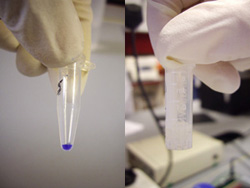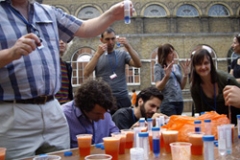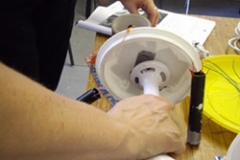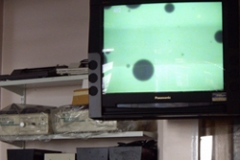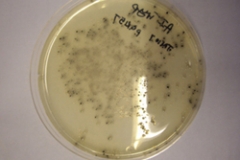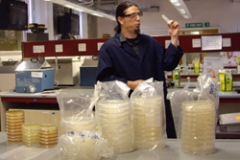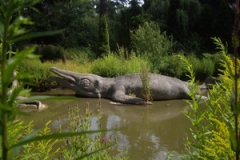Arts Catalyst, University College London, SymbioticA & Synthetic Aesthetics. UCL, London, UK. 2011
Synthesis, an intensive learning and discussion space for the emerging area of ‘synthetic biology’, led by Oron Catts (SymbioticA), Alexandra Daisy Ginsberg (Synthetic Aesthetics) and Professor John Ward (UCL), with support from the Arts Catalyst, Jane Calvert (Synthetic Aesthetics, Edinburgh University) and Jane Gregory (UCL).
During the week Synthesis explored the ethical, cultural, social and scientific implications on utilising, controlling, constructing and manipulation living systems. Practical sessions intersected with lectures, screenings, presentations and discussions by scientists, activists, artists and philosphers.
Synthetic biology can be described as as an emerging scientific discipline which uses wet-lab and engineering principles to create synthetic entities, commonly by using bacterium as a host. These can be entirely new entities or entities which are modified from existing life forms.
The week started with a ‘Brief History’ of Synthetic biology by Dr Jane Calvert. Jane Calvert outlined the history, politics and the capitalisation of life in this new area. Alistair Efflick (Edinburgh University) went on to describe the notion of ‘The Engineering Paradigm’ in synthetic biology which implements the application of engineering principles, specifically the ‘BioBricks’ standard as a part-based system for use in synthetic biology. Prof. John Ward gave a talk on ‘Microscopic Workhorses: Cells, Bacteria and DNA, RNA & Protein Synthesis’, which we demonstrated by ‘Plating Bacteria from the Environment’ and then by transforming E-coli with eGFP (enhanced green fluorescent protein). E-coli (escherichia coli) is a Gram-negative, rod-shaped bacterium typified by scientists as a ‘model organism’.
Fernan Federici (University of Cambridge) talked about his research- ‘Plant Synthetic Biology & Transforming Plants’ and the ‘bottom-up’ synthetic biology method- the ‘Gibson Assembly’. Christina Del Bianco (University of Trento) led the particpants of the lab through the ‘Gibson Assembly’ proccedure and described fabricating the new synthetic life as ‘Protolife: Constructing Cell Like Systems’.
‘The Dual Use Dilemma: Life and Death Science’ by Brian Rappert was particularly interesting as it placed the potential of synthetic biology into a number of contexts- the military, bio-terrorism, the public domain and institutional research. The political and capital context was outlined by Jim Thomas from the ‘etc’ group (…or Action Group on Erosion, Technology and Concentration) in ‘The Sins of Synbio’ from representing and working with civil grass root organisations and indigenous groups. ‘Synthia’ was coined by Jim Thomas, now used by the venture capitalist Craig Venter whose researchers allegedly created the first synthetic being.
Philosopher Emma Tobin presented a number of provocations to questions the taxonomy and classification of life in ‘ Life verses Biology’ using the philosophical plurist and reductionist approaches. She asked if – ‘synthetic biology is life, alive and should be able to be manipulated ?’. Dr. Nick Lane went on to define life and proposes that ‘the single origin of complex Life only arose once’ and that ‘natural genetic fusion of bacterium and archaea’ led to ‘eukaryotes’- multi-celled beings as plants and animals.
On the final day of the lab Ben Davis (University of Oxford) gave a talk on ‘Alternative Visions: Alternative futures for synthetic biology’ where synthetic biology was presented outside of the binary – good or bad dichotomy. Ben Davis talked about the ‘Quimi-Hib’ vaccine developed by Fidel Castro’s Cuban social programme of investing in science for medicine as a case study for synthetic biology. Finally, Synthesis concluded with a tour to Crystal Palace ‘Archaelogy of a Future Nature: Crystal Palace Dinosaurs’ led by historian and philosopher Joe Cain (UCL). These sculptural artefact are both simultaneously representational at the time and fictional, alluding to the great narrative of life as a constant simulation.
Links:
Synthesis lab Info and documentation:
– artscatalyst
– Synthetic Aesthetics: Daisy Ginsberg & Jane calvert
– SymbioticA
– Prof John Ward/UCL
– Jane Gregory/UCL
– Fernan Federici
– Jim Thomas: etcgroup.org
– Brian Rappert
